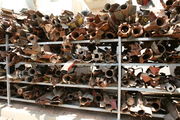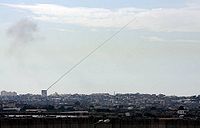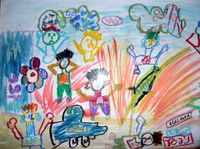Sderot
| Sderot | ||
 |
||
|
||
 Sderot
|
||
| District | South | |
| Government | City (from 1996) | |
| Hebrew | שְׂדֵרוֹת | |
| Arabic | سديروت | |
| Name meaning | Boulevards | |
| Population | 19,500 (2009) | |
| Area | 4,472 dunams (4.472 km2; 1.727 sq mi) | |
| Mayor | David Buskila | |
| Founded in | 1953 | |
| Coordinates | ||
Sderot (Hebrew: שְׂדֵרוֹת) is a western Negev city in the Southern District of Israel. According to the Israel Central Bureau of Statistics (CBS), at the end of 2006 the city had a total population of 19,300.[1] The city has been an ongoing target of Qassam rocket attacks from the Gaza Strip. In March 2008, the mayor said the population had declined by 10%-15% as families left the city in desperation (aid organizations say the figure is closer to 25%). Many of the families that remain cannot afford to move out or are unable to sell their homes.[2]
Sderot, less than a mile from Gaza, has been the target of Palestinian rocket attacks that have killed 13 residents, wounded hundreds, caused millions of dollars in damage, disrupted daily life and wreaked havoc on the local economy.[3] According to MSNBC, "nearly everyone [has been] traumatized by the frequent sound of air-raid sirens and explosions of incoming projectiles". All local schools have been fortified.[4] From mid-June 2007 to mid-February 2008, 771 rockets and 857 mortar bombs were fired at Sderot and the western Negev, an average of three or four each a day.[5]
Contents |
History
Sderot was founded in 1951 as a transit camp for Kurdish and Persian Jewish immigrants who lived in tents and shacks before permanent housing was completed in 1954. In 1956, Sderot was recognized as a local council.[6] The city is located just south of the ruins of the Palestinian village of Najd. During the 1948 Arab-Israeli war, the village was occupied by Israeli troops, and the inhabitants were expelled and fled to what is now the Gaza Strip. According to Walid Khalidi, Sderot's land had belonged to the village.[7]

In the 1961 census, the percentage of North African immigrants, mostly from Morocco, was 87% in the town, whilst another 11% of the residents were immigrants from Kurdistan.[8] In the 1950s, the city continued to absorb a large number of immigrants from Morocco and Romania, and was declared a local council in 1958.
Sderot again absorbed a large immigrant population during the Aliyah from the Soviet Union in the 1990s, and its population doubled in this decade. In 1996 it was declared a city.
Rocket fire from Gaza

Sderot lies one kilometer from the Gaza Strip and town of Beit Hanoun. Since the beginning of the Second Intifada in October 2000, the city has been under constant rocket fire from Qassam rockets launched by Hamas and Islamic Jihad.[9] Despite the imperfect aim of these homemade projectiles, they have caused deaths and injuries, as well as significant damage to homes and property, psychological distress and emigration from the city. The Israeli government has installed a "Red Color" (צבע אדום) alarm system to warn citizens of impending rocket attacks, although its effectiveness has been questioned. Citizens only have 15 seconds to reach shelter after the sounding of the alarm. Thousands of Qassam rockets have been launched since Israel's disengagement from the Gaza Strip in September 2005.
In May 2007, a significant increase in shelling from Gaza prompted the temporary evacuation of thousands of residents.[10] By November 23, 2007, 6,311 rockets had fallen on the city.[11] Yediot Ahronoth reported that during the summer of 2007, 3,000 of the city's 22,000 residents (comprised mostly of the city's key upper and middle class residents) left for other areas, out of Qassam rocket range. Russian billionaire Arcadi Gaydamak organized a series of relief programs for residents unable to leave.[12] On December 12, 2007, after more than 20 rockets landed in the Sderot area in a single day, including a direct hit to one of the main avenues, Sderot mayor Eli Moyal announced his resignation, citing the government's failure to halt the rocket attacks.[13] Moyal was persuaded to retract his resignation.
In a gesture of solidarity, El Al (Israel's national airline) named one of its first two Boeing 777 passenger planes "Sderot" (the other was named for Kiryat Shmona).[14]
| Palestinian rocket attacks on Israel |
|---|

|
| By year |
| 2001 · 2002–2006 · 2007 2008 · 2008 cease-fire Gaza War · 2009 · 2010 |
| Groups responsible |
| Fatah · Hamas · Islamic Jihad Democratic Front for the
Popular Resistance CommitteesLiberation of Palestine Ansar al-Sunna · Force 17 |
| Rocket types |
| Mortar · Qassam · Al-Quds Katyusha · Grad |
| Cities hit |
| Ashdod · Ashkelon · Beersheba Gedera · Kiryat Gat · Kiryat Malakhi Netivot · Sderot · Ofakim · Yavne |
| Regional Council areas hit |
|
Hof Ashkelon
(Karmia · Netiv HaAsara Yad Mordechai · Zikim) Eshkol
(Nir Oz · Nirim · Yesha) Sha'ar HaNegev
(Kfar Aza · Nahal Oz · Nir Am) Sdot Negev
(Sa'ad) Merhavim
|
| Settlements hit (evacuated) |
| Atzmona · Dugit · Elei Sinai Gadid · Ganei Tal · Katif Kfar Darom · Morag Netzarim · Netzer Hazani Neve Dekalim · Nisanit Rafiah Yam · Slav |
| Defenses |
| Civil defense in Israel Red Color · Iron Dome · ZAKA |
| Related topics |
| Israeli-Palestinian conflict Palestinian political violence Palestinian suicide attacks Palestinian animal bomb attacks Lebanese rocket attacks on Israel |
In January 2008, the Jewish Community Relations Council of New York organized a display of 4,200 red balloons outside the United Nations building.[15] Each balloon represented a Qassam rocket that had been fired into Sderot,[16] where for years the town and its surrounding area have been under near-constant bombardment by thousands of rockets and mortar shells fired from Gaza.[17] Consul David Saranga, who conceptualized the display, said he used the balloons as an opportunity to call upon the international community to stop ignoring what’s happening in Israel.[18] The balloon display made headlines in New York City papers as well as international publications.[19]
The Gaza War at the beginning of 2009 largely put an end to the shelling from the Gaza Strip. However, charitable donations to the city have since ceased, and one year later the municipality is threatening to declare bankruptcy. [20]
Culture
According to the Jerusalem Post, an unusually high ratio of singers, instrumentalists, composers and poets have come from this small town.[21] In 2007 American-Israeli filmaker Laura Bialis immigrated from California to Sderot "to find out what it means to live in a never-ending war, and to document the lives and music of musicians under fire."[22]
Several popular bands have been formed by musicians who practiced in Sderot's bomb shelters as teenagers.[23][24][25] Because Sderot is a poor, immigrant town with high unemployment experiencing a dramatic musical success as bands blend international sounds with the music of their Moroccan immigrant parents, it has been compared to Liverpool in the sixties.[26][27] Among the notable bands are Teapacks [28] Knesiyat Hasekhel and Sfatayim.[29] Well-known musicians from Sderot include Shlomo Bar, Kobi Oz, Haïm Ulliel and Smadar Levi.
Israeli poet Shimon Adaf was born in Sderot,[21] as well as the actor and entertainer Maor Cohen. Adaf dedicated a poem to the city in his 1997 book Icarus' Monologue.
Documentary filmmaker Laura Bialis, currently living in Sderot, is making a film entitled Sderot: Rock in the Red Zone, scheduled for release in 2009, that focuses on young musicians living under the daily threat of Qassams.[30][31][32]
Demographics
According to CBS, in 2001 the ethnic makeup of the city was 99.8% Jewish, without significant Arab population. There were 9,500 males and 9,700 females. The age distribution of the city was as follows: 36.5% 19 years of age or younger, 16.2% between 20 and 29, 19.6% between 30 and 44, 14.3% from 45 to 59, 3.8% from 60 to 64, and 9.5% 65 years of age or older. The population growth rate in 2004 was 0.7%.
A number of Palestinian Arab collaborators from the Gaza Strip were resettled in Sderot beginning in 1997 after cooperating with the Shin Bet.[33]
Economy
According to CBS figures for 2000, there were 6,301 salaried workers and 367 self-employed in Sderot. The mean monthly wage was NIS 3,845, a real change of 9.0% over the course of 2000. Salaried males had a mean monthly wage of NIS 4,911 (a real change of 11.3%) versus NIS 2,665 for females (a real change of 2.4%). The mean income for the self-employed was NIS 5,378. 603 citizens received unemployment benefits and 3,183 received income supplements.
Hollandia International, founded in 1981, a company that manufacturers and exports high-end mattresses, moved its sole manufacturing center to Sderot 11 years ago. Due to the incessant rocket attacks, Hollandia has been forced to relocate.[34]
Sderot is also the first location in Israel to offer WiMAX services, with a WiMAX service for educational institutions initiated on January 8, 2009 by the 012 Smile ISP and the communications ministry.[35]
The Osem plant in Sderot, opened in 1981, is the region's major employer, with 480 workers. 170 products are manufactured there, including Bamba, Bisli, Mana Hama instant noodle and rice dishes, instant soup powders, shkedei marak, ketchup and sauces.[36]
The Menorah Candle factory located in Sderot exports Hanukkah candles all over the world.[37]
Nestlé Also has a research and development facility in Sderot,[38] established in 2002. Production facilities for Nestlé are also located in Sderot that produce breakfast cereals.[39]
Education

According to CBS, there are 14 schools and 3,578 students in the city. They are spread out as eleven elementary schools and 2,099 elementary school students, and six high schools and 1,479 high school students. 56.5% of 12th grade students were entitled to a matriculation certificate in 2001. Rafeeque Ansari. Sapir Academic College[40] and the Hesder Yeshiva of Sderot are located in Sderot.
International relations
Twin towns — Sister cities
Sderot is twinned with:
 Antony, France
Antony, France
Notable residents
- Amir Peretz, former defense minister
- Kobi Oz, lead singer of Teapacks
- Miri Bohadana, model
- Shlomo Bar
- Laura Bialis
- Smadar Levi
- Erez Biton
- Shimon Adaf
- Haïm Ulliel
See also
- List of Qassam rocket attacks
- List of twin towns and sister cities in Israel
References
- Notes
- ↑ "Table 3 - Population of Localities Numbering Above 1,000 Residents and Other Rural Population" (PDF). Israel Central Bureau of Statistics. 2008-06-30. http://www.cbs.gov.il/population/new_2009/table3.pdf. Retrieved 2008-10-18.
- ↑ Hadad, Shmulik (2008-03-19). "Sderot: Those Who Can Afford It Have Already Left". Ynetnews. http://www.ynetnews.com/articles/0,7340,L-3520956,00.html. Retrieved 2008-10-20.
- ↑ "2 Israelis Lightly Wounded as 33 Rockets Slam in Western Negev". Haaretz. http://www.haaretz.com/hasen/spages/959907.html. Retrieved 2009-01-16.
- ↑ AP: School resumes in Israel despite rocket threat, Jan. 11, 2009
- ↑ "Qassam Rockets - Background and Statistics". Zionism-Israel.com. http://zionism-israel.com/vic/Sderot_Qassam_Statistics_Summary_2007.htm. Retrieved 2008-10-20.
- ↑ HaReuveni, Immanuel (1999), Lexicon of the Land of Israel. Yedioth Ahronoth Publishing. ISBN 965-448-413-7 (Hebrew)
- ↑ Walid Khalidi, 1992; "All That Remains: The Palestinian Villages Occupied and Depopulated by Israel in 1948", p. 128.
- ↑ Rapoport, Meron (2007-05-25). "The Pioneers of Sderot". Haaretz. http://www.haaretz.com/hasen/spages/863249.html. Retrieved 2008-10-20.
- ↑ Silverman, Anav (2007-09-20). "A City Under Siege: An Inside View of Sderot, Israel". Sderot Media Center. http://sderotmedia.com/?p=372. Retrieved 2008-10-20.
- ↑ Kershner, Isabel (2007-05-31). "Israeli Border Town Lives in the Shadow of Falling Rockets". International Herald Tribune. http://www.iht.com/articles/2007/05/31/europe/town.php. Retrieved 2008-10-20.
- ↑ Sackett, Shmuel (2007-12-07). "23 Years and 6,311 Rockets". Israel Insider. http://web.israelinsider.com/views/12461.htm. Retrieved 2008-10-20.
- ↑ "3,000 Sderot Residents Have Left Town". The Jerusalem Post. 2007-11-16. http://www.jpost.com/servlet/Satellite?c=JPArticle&cid=1192380747715&pagename=JPost%2FJPArticle%2FShowFull. Retrieved 2008-10-20.
- ↑ "Israeli Mayor Quits Over Rockets". BBC Online. 2007-12-12. http://news.bbc.co.uk/2/hi/middle_east/7140784.stm. Retrieved 2008-10-20.
- ↑ Boeing 777 Named for Sderot, infolive.tv, 2007-07-31, http://www.infolive.tv/en/infolive.tv-10224-israelnews-el-als-ace-hat-boeing-777, retrieved 2008-10-20
- ↑ 4,200 balloons released in NY to protest Qassam fire, By Neta Sela, Ynet News, January 24, 2008.
- ↑ Israeli mission in N.Y. displays 4,200 balloons, one for each Qassam, Haaretz, Published January 25, 2008.
- ↑ Balloon for each Kassam on UN doorstep, By Itamar Sharon, Jerusalem Post, Published January 24, 2008.
- ↑ Meet David Saranga, the man whose campaigns are rebranding Israel, David Russell, The Jewish Chronicle, Published May 23, 2008.
- ↑ Balloons for Sderot, AP Images, Published January 2008.
- ↑ http://www.haaretz.com/hasen/pages/ShArtVty.jhtml?sw=Sderot&itemNo=1158635 Yanir Yagna, "Rocket-battered Sderot faces bankruptcy", Haaretz, 24 March 2010
- ↑ 21.0 21.1 Grapevine: Away from the rockets' red glare, Geer Fay Cashman, June 24, 2006, Jerusalem Post [1]
- ↑ "Rockets may fall, but Sderot continues to rock". 2009-01-15. http://www.israel21c.org/bin/en.jsp?enDispWho=Articles^l2421&enPage=BlankPage&enDisplay=view&enDispWhat=object&enVersion=0&enZone=Culture&. Retrieved 2009-01-31.
- ↑ Sounds from another country, By Kobi Ben-Simhon, Haaretz, 08/11/07
- ↑ Sderot, A Love Story, The Jewish Week, Gary Rosenblatt, 06/18/2008
- ↑ Borderland Pop: Arab Jewish Musicians and the Politics of Performance, Galit Saada-Ophir, Hebrew University of Jerusalem , Cultural Anthropology Volume 21 Issue 2, Pages 205 – 233, 7 Jan 2008
- ↑ Teapacks interview, Caroline Westbrook, something Jewish, 09/05/2007
- ↑ "The Official Sderot Movie Website :: Movie : Music : Musicians". Sderotmovie.com. 2008-12-13. http://sderotmovie.com/blog/2008/12/13/a-year-in-sderot. Retrieved 2010-04-04.
- ↑ "teapacks". teapacks. http://www.teapacks.com. Retrieved 2010-04-04.
- ↑ "Sefatayim". Israel-music.com. http://www.israel-music.com/sefatayim/. Retrieved 2010-04-04.
- ↑ Zaitchik, Alexander (2008-03-16). "Documentary Pulls Back Iron Curtain". The Forward. http://www.forward.com/articles/13398/. Retrieved 2008-10-20.
- ↑ Fuma, Simona (2008-04-23). "Rebel With a Cause". World Jewish Digest. http://www.worldjewishdigest.com/ME2/dirmod.asp?sid=&nm=&type=Publishing&mod=Publications%3A%3AArticle&mid=8F3A7027421841978F18BE895F87F791&tier=4&id=0A6EBD249B8C4CF49401601D6627FC42. Retrieved 2008-10-20.
- ↑ Lash Balint, Judy (2008-03-02). "Only Thirty-Six Hours in Sderot". San Diego Jewish World. http://www.jewishsightseeing.com/2008-SDJW/20080302-jewish-sun53.html#Balint. Retrieved 2008-10-20.
- ↑ Hadad, Shmulik (2007-05-30). "Palestinian Collaborator: Terrorists Only Understand Force". Ynetnews. http://www.ynetnews.com/articles/0,7340,L-3406314,00.html. Retrieved 2008-10-20.
- ↑ http://www.jpost.com/servlet/Satellite?cid=1200572482270&pagename=JPost%2FJPArticle%2FShowFull
- ↑ "Mobile WiMAX Initiative Launched in Sderot". January 9, 2008. http://www.wimax.com/commentary/news/wimax_industry_news/mobile-wimax-initiative-launched-in-sderot. Retrieved 2009-02-04.
- ↑ Nestle honcho drops in to see Bamba baby
- ↑ Hanukkah miracles all around, Haaretz
- ↑ "R&D Sderot, Israel". Nestle.com. http://www.nestle.com/NestleResearch/GlobalRnD/ResearchCenters/RnDSderot.htm?wbc_purpose=Basic&WBCMODE=PresentationUnpublis. Retrieved 2010-04-04.
- ↑ "Nestle producing new breakfast cereal in Sderot - Israel Business, Ynetnews". Ynetnews. 1995-06-20. http://www.ynetnews.com/articles/0,7340,L-3725743,00.html. Retrieved 2010-04-04.
- ↑ Sapir Academic College
External links
- Sderot Media Center
- The Other Voice
- Humanitarian aid organization in Sderot
- Sderot; The Movie, [2]
- sderot portal-hebrew
- Sderot Information Center for the Western Negev
- The committee for a secure Sderot
- Sderot in The Washington Post
- SDEROT JOURNAL An Israeli Playground, Fortified Against Rockets
|
||||||||||||||||||||
